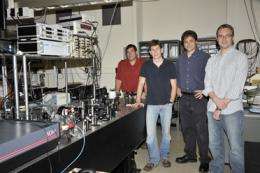Researchers discover technique to improve solar cell technology

A multi-disciplinary team of scientists at the Naval Research Laboratory has discovered a way to tailor nanostructures that could result in low-cost, high efficiency solar cells. The research appears in the August 10, 2011 issue of the journal Nano Letters.
The technology behind optoelectronic devices currently in use has been limited by the fact that a single photon absorbed by a semiconductor results in the creation of a single electron-hole pair, or exciton. The NRL researchers have found that changing the shape of PbSe (lead selenide) nanostructures enhances a down conversion process known as multiple exciton generation. To accomplish this, the team uses elongated (cigar-shaped) nanorods instead of spherically symmetric (ball-like) nanocrystals.
Unlike the current optoelectronic technology that relies on a single electron-hole pair per photon, in multiple exciton generation the excess energy of the "hot" exciton is used to excite a second electron across the band gap resulting in the creation of two or more excitons per photon. The NRL team's discovery that this process is significantly more efficient in the elongated nanorod structures provides a new pathway to increasing the efficiency of solar cells over current state-of-the-art devices.
These elongated structures are the most efficient photon energy down converters known. As a result, this material system provides a way of harvesting solar energy extremely efficiently. In addition, the synthesis process is low cost, which would make these solar cells very inexpensive, and the materials are compatible with solution processing of devices on flexible substrates. Possible future applications emerging from this technology besides photovoltaic cells could include ultra-sensitive photodetectors, high-speed electronics, light emitting diodes, lasers, and biological labels.
The research team consists of Drs. Paul Cunningham, Janice Boercker, Matthew Lumb, Joseph Tischler, and Joseph Melinger from NRL's Electronics Science and Technology Division; and Drs. Edward Foos and Anthony Smith from NRL's Chemistry Division.
Provided by Naval Research Laboratory
















